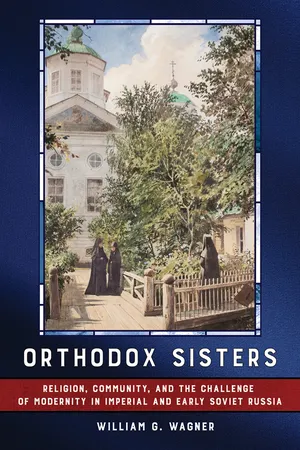
NIU Series in Orthodox Christian Studies
Religion, Community, and the Challenge of Modernity in Imperial and Early Soviet Russia
- 414 pages
- English
- ePUB (mobile friendly)
- Only available on web
NIU Series in Orthodox Christian Studies
Religion, Community, and the Challenge of Modernity in Imperial and Early Soviet Russia
About This Book
Orthodox Sisters explores the relationship between women, religion, and social, cultural, and economic change between 1700 and 1935 through the experiences of Orthodox convents in Nizhnii Novgorod diocese. Focusing primarily on the Convent of the Exaltation of the Cross, William G. Wagner places the women's experiences in the broader context of developments in female monasticism and religious life in Russia, as well as in Europe and North America over the same period.
This is the first comprehensive study that follows a Russian convent through all the stages of its life—from its origins in the eighteenth century to its flourishing at the turn of the twentieth century, to its resistance to Soviet assault, and, finally, to its rebirth in the 1920s. By the late nineteenth century, the Convent of the Exaltation of the Cross and the other convents and women's religious communities in Nizhnii Novgorod diocese constituted a reimagined form of a traditional Orthodox monastic community. Wagner shows how these nuns and novices adapted to the conditions of emergent modernity in a distinctively Orthodox way.
When almost everything but their communal life, work, and worship and their sacred spaces had been stripped away and they were subject to the socialist state's efforts at subversion, the sisters of the Convent of the Exaltation of the Cross and the other convents in the diocese created an authentic Christian community that gave their lives a collective meaning. In this way they were able to lead a rewarding life and survive the early years of Soviet Russia.
Frequently asked questions
Information
Table of contents
- List of Illustrations and Tables
- Foreword by Christine D. Worobec and Roy R. Robson
- Acknowledgments
- Note on Sources and Methodology
- Note on Transliteration
- Introduction: Monasticism, Modernity, and Women
- 1. Origins
- 2. Transformations
- 3. Religious Life, Community, and Cultural Meanings
- 4. Post-emancipation Transformation and Growth
- 5. Upholding Orthodoxy in Troubled Times
- 6. Revolution and Dissolution
- Conclusion: Female Monasticism, Empowerment, and Adaptation
- Epilogue: Resurrection
- Appendix
- List of Abbreviations
- Notes
- Sources Cited
- Index